Understanding the Anatomy of a Refrigerator: The Cooling System Explained
Ever wondered what's actually happening inside your fridge? That quiet hum in your kitchen is actually an impressive feat of engineering at work! The anatomy of refrigerator systems is like a well-choreographed dance of physics and chemistry, working tirelessly to keep your food fresh and safe.
Your refrigerator doesn't actually "create cold" – instead, it cleverly removes heat from inside and transfers it outside. This process relies on four essential components working together in perfect harmony.
The compressor serves as the beating heart of your refrigerator. This workhorse pumps refrigerant throughout the system, compressing it into a hot, high-pressure gas that's ready to begin its cooling journey.
Next, this hot gas travels to the condenser coils – those snake-like tubes typically found on the back or bottom of your fridge. Here, the refrigerant releases its heat (that's why this area feels warm to the touch) and transforms from a gas into a liquid.
The refrigerant then passes through an expansion device (either a valve or capillary tube), where something magical happens. As the liquid refrigerant's pressure suddenly drops, it cools dramatically and partially converts to gas – much like how an aerosol can feels cold when sprayed.
Finally, this cold refrigerant flows through the evaporator coils inside your fridge. As it absorbs heat from your leftovers and milk cartons, it completely evaporates into a gas, effectively pulling warmth out of your refrigerator's interior. The cycle then repeats, keeping everything perfectly chilled.
I'm Mortuary Cooler, and after nearly a decade designing specialized cooling systems, I can tell you that mortuary refrigeration relies on these same fundamental principles. The main difference? Our professional units require more precise temperature control and improved reliability – but the anatomy of refrigerator technology remains remarkably similar across applications.
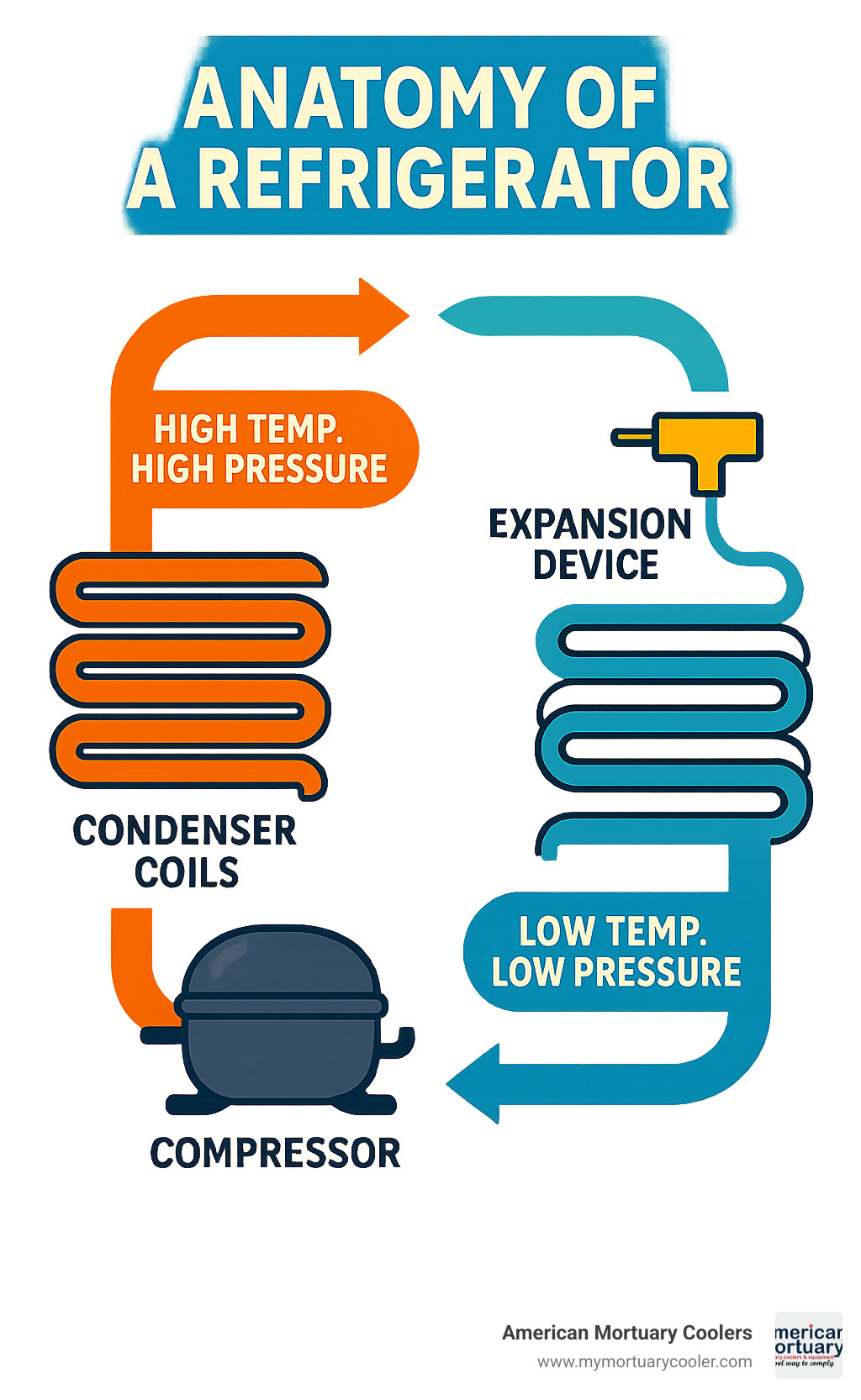
Want to learn more about specialized cooling systems? Check out our detailed guides on mortuary refrigeration systems, specimen refrigerator technology, and body fridge designs. These specialized applications build upon the same refrigeration principles that keep your ice cream frozen at home!
Anatomy of Refrigerator: Core Components & Refrigeration Cycle
The fundamental anatomy of refrigerator technology hasn't changed dramatically since Jacob Perkins patented the vapor-compression cycle in 1835. It's fascinating to realize that refrigerators don't actually create cold—they simply remove heat! This continuous cycle involves four essential components working together like a well-rehearsed orchestra.
The Compressor: The Heart of Your Refrigerator
Tucked away at the bottom or rear of your fridge is the mighty compressor—the true heart of your cooling system. This hardworking component keeps everything running smoothly day and night.
This powerful motor-driven pump begins by drawing in low-pressure refrigerant gas from the evaporator. It then compresses this gas (hence the name!), significantly raising both its temperature and pressure. Finally, it pumps this hot, high-pressure gas onward to the condenser coils.
As refrigeration experts often say, "Your compressor is like your heart, circulating refrigerant throughout the system just as your heart pumps blood through your body." It's no wonder most manufacturers offer 10-year limited warranties on compressors—they're that important!
Condenser Coils: The Heat Releaser
Ever noticed that warm air near the back or bottom of your refrigerator? That's the condenser coils hard at work! Typically located either on the back or underneath your fridge, these coils play a crucial role in the cooling process.
The condenser coils receive that hot, high-pressure refrigerant gas from the compressor and release its heat into your kitchen air. As the refrigerant cools, it transforms from a gas into a liquid while maintaining high pressure. It's like magic, except it's actually science!
Expansion Device: The Pressure Reducer
Between the high-pressure and low-pressure sides of your refrigeration system sits the expansion device—either an expansion valve or a capillary tube. This small but mighty component creates a sudden pressure drop as refrigerant passes through, causing the liquid refrigerant to partially vaporize or "flash."
These precision devices control the flow rate of refrigerant into the evaporator with remarkable accuracy. Some expansion valves have diameters ranging from just 0.5 to 0.28 mm, depending on the refrigerator's design. That's smaller than a pin head but critically important to your fridge's performance!
Evaporator Coils: The Cold Maker
Hidden behind panels in your freezer section or refrigerator compartment are the evaporator coils—where the actual "cooling" happens. As the refrigerant moves through these coils, it absorbs heat from inside your refrigerator while evaporating from a mixed liquid-vapor state to a pure vapor.
This heat absorption creates the cooling effect that keeps your leftover lasagna fresh and your ice cream frozen. Once the refrigerant has done its job, it returns to the compressor as a low-pressure vapor, and the whole beautiful cycle begins again.
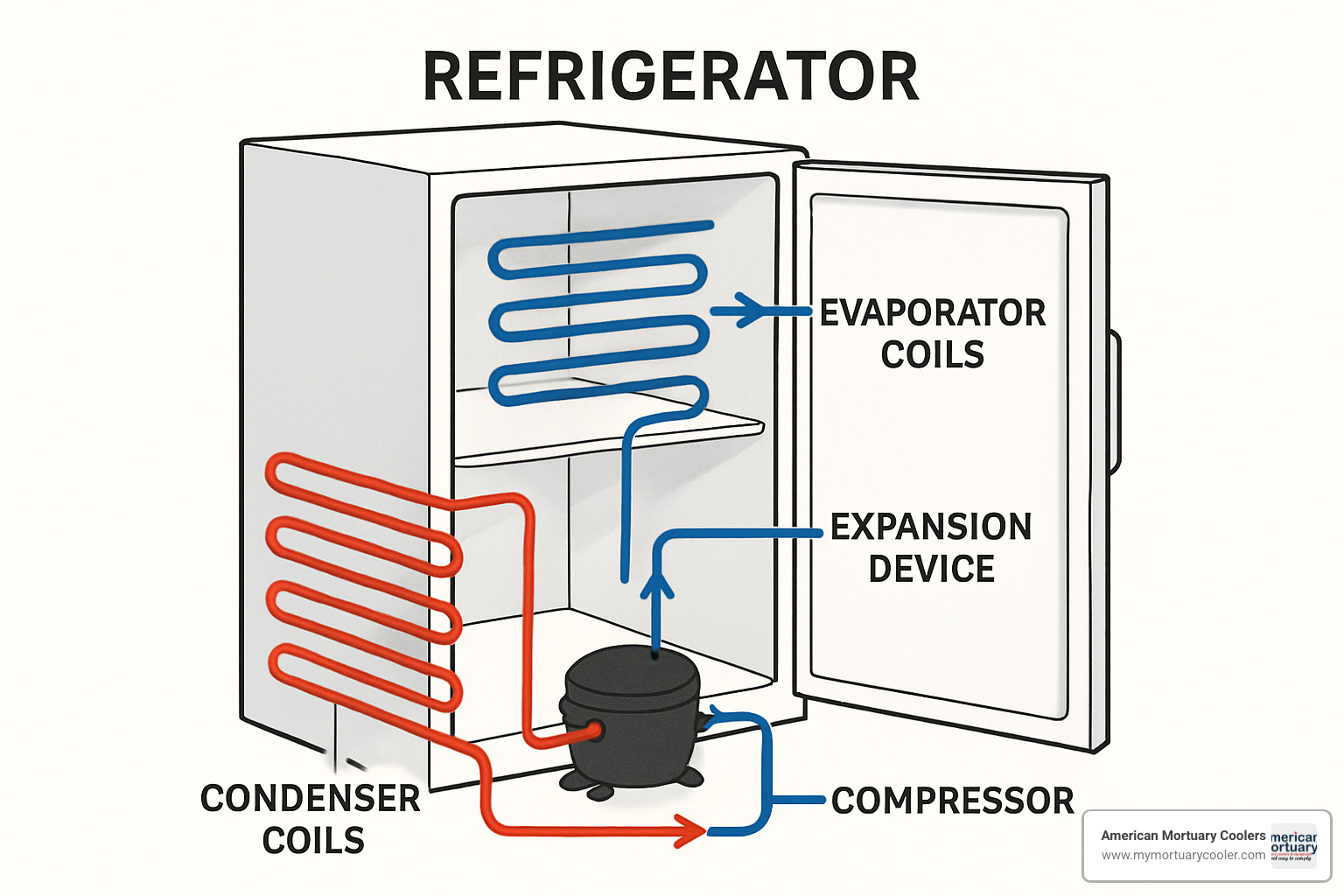
How the Anatomy of Refrigerator Creates Cold
The anatomy of refrigerator cooling systems relies on some fascinating physics principles. Think about sweating on a hot day—as moisture evaporates from your skin, it takes heat with it, cooling you down. Your refrigerator works on the same principle!
When the refrigerant evaporates inside your fridge, it absorbs heat from the interior. This process depends on pressure manipulation to control the refrigerant's boiling point, the latent heat of vaporization (the heat absorbed during evaporation), and changes in enthalpy (total heat content) as the refrigerant moves through the system.
It's like your refrigerant is "sweating" inside your fridge, carrying away heat with each cycle. Pretty cool, right? Or should I say... pretty warm, since it's removing heat!
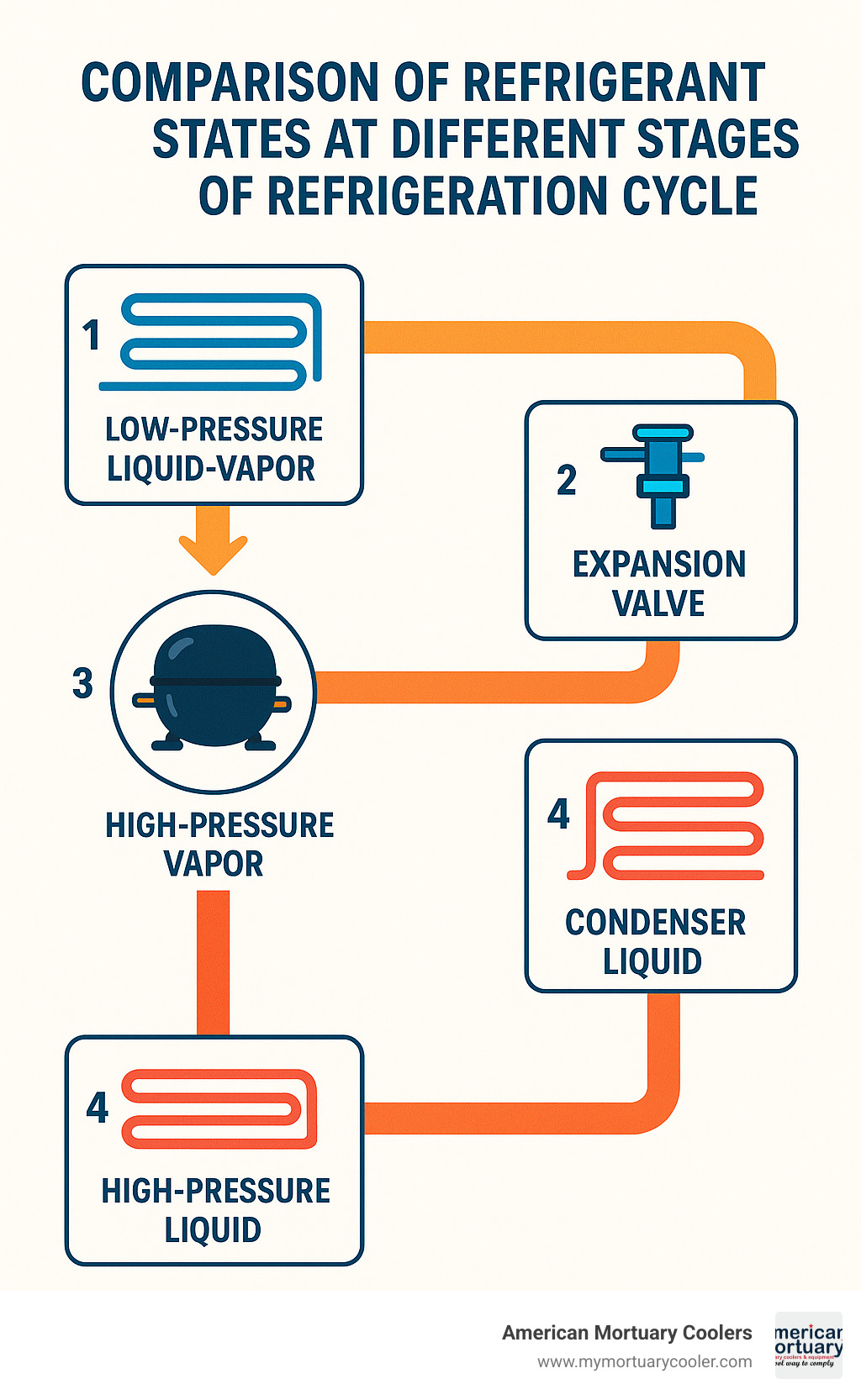
Anatomy of Refrigerator Safety & Environmental Evolution
The anatomy of refrigerator systems has come a long way since the early days. Your grandparents' refrigerator likely used chemicals we now know were harmful to our environment.
Before the 1930s, refrigerators used toxic gases like ammonia—effective but dangerous. Then came the Freon era, when chlorofluorocarbons (CFCs) were hailed as miracle refrigerants—until scientists finded they were punching holes in our ozone layer. Oops!
The 1987 Montreal Protocol marked a turning point, beginning the phase-out of these ozone-depleting refrigerants. An interim solution, HCFC-22, reduced ozone depletion by 95% compared to CFCs, but we didn't stop there.
Today's refrigerators typically use HFC-134a or newer HFO refrigerants with zero ozone depletion potential. Looking ahead, manufacturers are exploring natural refrigerants like propane and isobutane for smaller systems—balancing both ozone protection and reduced global warming impact.
This environmental evolution reminds us that even the most common household appliances continue to improve, becoming safer for both our families and our planet. The scientific research on vapor-compression continues to advance this technology into an ever more efficient and environmentally friendly future.
Door Anatomy, Temperature Zones & Modern Features
The anatomy of refrigerator doors and compartments isn't just about keeping the cold air in—it's a masterpiece of design that balances temperature control with everyday convenience. Let's peek behind the door and see what makes these cooling marvels work so well.
Door Gaskets: The Crucial Seal
Ever noticed that soft, flexible strip around your refrigerator door? That's the gasket—the unsung hero of refrigeration efficiency. This rubber or vinyl seal creates a tight accept around the entire door perimeter when closed, preventing precious cold air from escaping into your kitchen.
Think of your gasket as the refrigerator's security guard. It contains hidden magnets that snap the door firmly shut, ensuring no cold air sneaks out while you're not looking. A healthy gasket means your compressor doesn't have to work overtime, saving energy and extending your fridge's lifespan.
"A worn gasket can increase energy consumption by up to 15%," notes refrigeration experts. "It's like leaving your front door slightly ajar during winter—your heating system would never stop running."
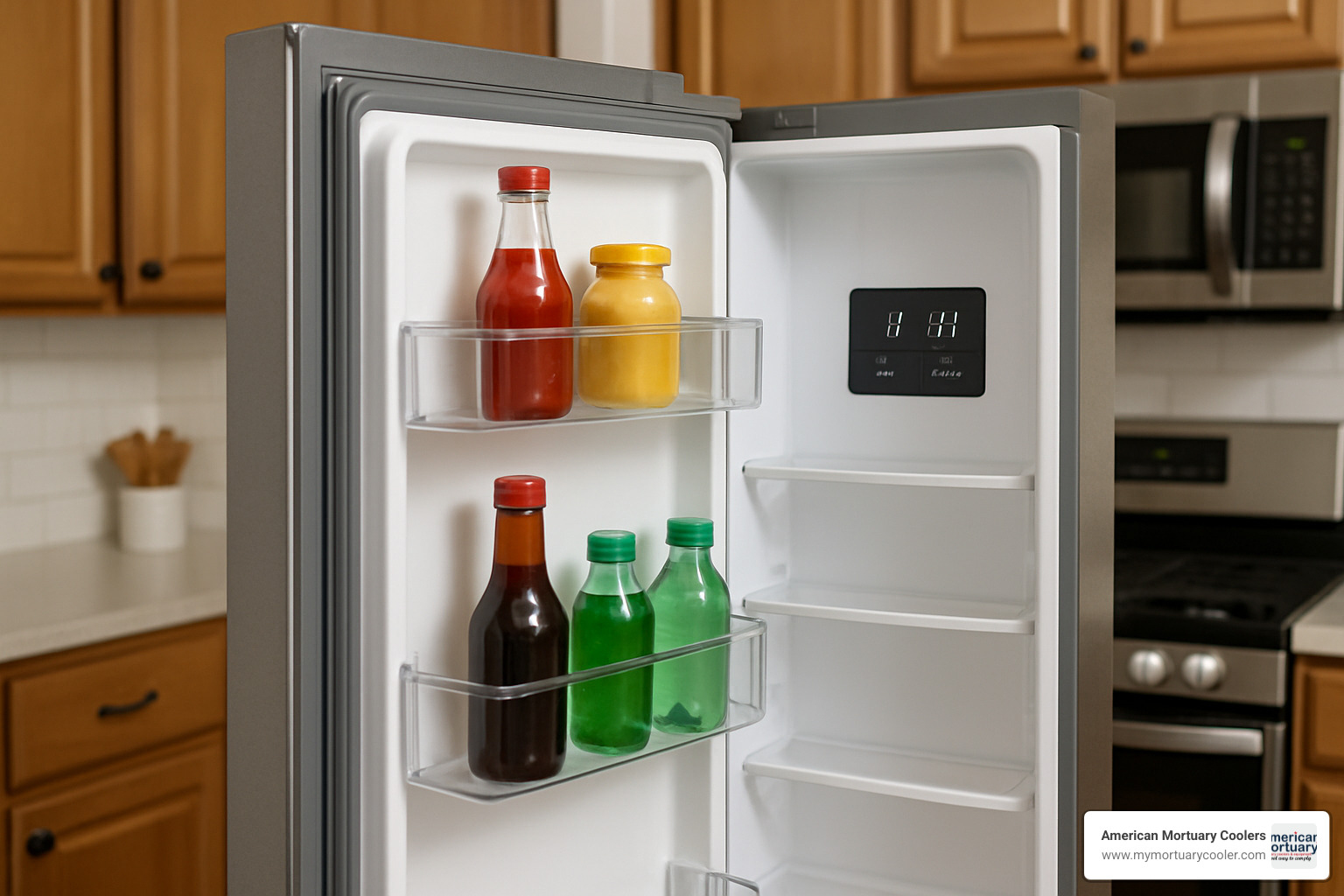
Interior Door Components
Your refrigerator door isn't just a barrier—it's valuable real estate! Modern doors feature adjustable bins and shelves that transform what would be wasted space into perfect homes for condiments, beverages, and tall items. Many contemporary models include ice and water dispensers built right into the door, saving you from opening the main compartment for a quick drink.
The control panel, often located on the door for easy access, puts temperature adjustments and special features at your fingertips. Some newer models even include touch screens that can display recipes or family photos when not being used to adjust settings.
Temperature Zones and Airflow Management
Did you know your refrigerator has its own climate zones? Just like Earth has tropics and polar regions, your fridge maintains different temperature areas optimized for various foods.
The coldest spots are typically near the bottom, since cold air naturally sinks. This makes lower shelves perfect for raw meat and seafood. Door shelves tend to be the warmest areas—ideal for condiments and drinks that don't require the coldest storage. The upper shelves maintain a happy medium, perfect for leftovers and ready-to-eat foods.
Your refrigerator manages these temperature variations through a network of air vents that circulate cold air from the evaporator throughout the cabinet. Dampers (adjustable openings) control the airflow between compartments, while evaporator fans ensure air moves across the cooling coils and throughout the interior.
Modern Refrigerator Features
Today's refrigerators would make our grandparents' heads spin with their advanced features. Thermistors (electronic temperature sensors) provide far more precise temperature control than old-school mechanical thermostats. Sophisticated control boards act as the fridge's brain, managing everything from defrost cycles to temperature adjustments.
High-end models often feature dual evaporators that create separate cooling systems for the freezer and refrigerator compartments. This prevents odor transfer and maintains ideal humidity levels in each section. Energy-efficient LED lighting has replaced traditional bulbs, producing less heat and lasting much longer.
For tech enthusiasts, smart refrigerators with Wi-Fi connectivity allow you to adjust settings from your phone or receive alerts if the door is left open. Some can even help track your grocery inventory or suggest recipes based on what's inside!
Crisper Drawers and Specialized Storage
The humble crisper drawer deserves special recognition in the anatomy of refrigerator compartments. These specialized bins create the perfect microclimate for fruits and vegetables with adjustable humidity settings. The slider controls you see on most crispers regulate airflow, allowing you to create drier conditions for fruits (which emit ethylene gas as they ripen) and higher humidity for vegetables (which need moisture to stay crisp).
Beyond crispers, modern refrigerators offer an array of specialized storage options: wine racks that store bottles horizontally, butter compartments with temperature control for perfect spreadability, pull-out shelves for easy access to items in the back, and spill-proof shelving that contains leaks before they become major cleanup projects.
For more information about specialized cooling features, check out this complete guide to Walk-In Cooler features and prices, which explores commercial-grade cooling solutions that use many of the same principles as your home refrigerator, just on a larger scale.
Maintenance, Troubleshooting & Replacement Parts
Understanding the anatomy of refrigerator components isn't just for appliance geeks – it's the secret to keeping your fridge running efficiently for years to come. A well-maintained refrigerator isn't just less likely to break down when you've just stocked up after a Costco run (we've all been there!), it's also significantly more energy-efficient. In fact, a neglected fridge can guzzle up to three times more electricity than one that receives regular TLC.
Essential Maintenance Tasks
Condenser Coil Cleaning
Think of your condenser coils as your refrigerator's lungs. When they're clogged with dust and pet hair, your fridge has to work harder to breathe – and cool.
"Cleaning condenser coils is like giving your refrigerator a breath of fresh air," explains our technical team at American Mortuary Coolers. "Just as our specialized mortuary units require immaculate coils for precise temperature control, your home refrigerator needs clean coils to operate efficiently."
For best results, clean those coils every 2-3 months (more often if you have pets shedding all over your home). Simply unplug your fridge, locate the coils (usually on the back or underneath), and gently vacuum away dust using a brush attachment. This five-minute task can significantly extend your refrigerator's lifespan.
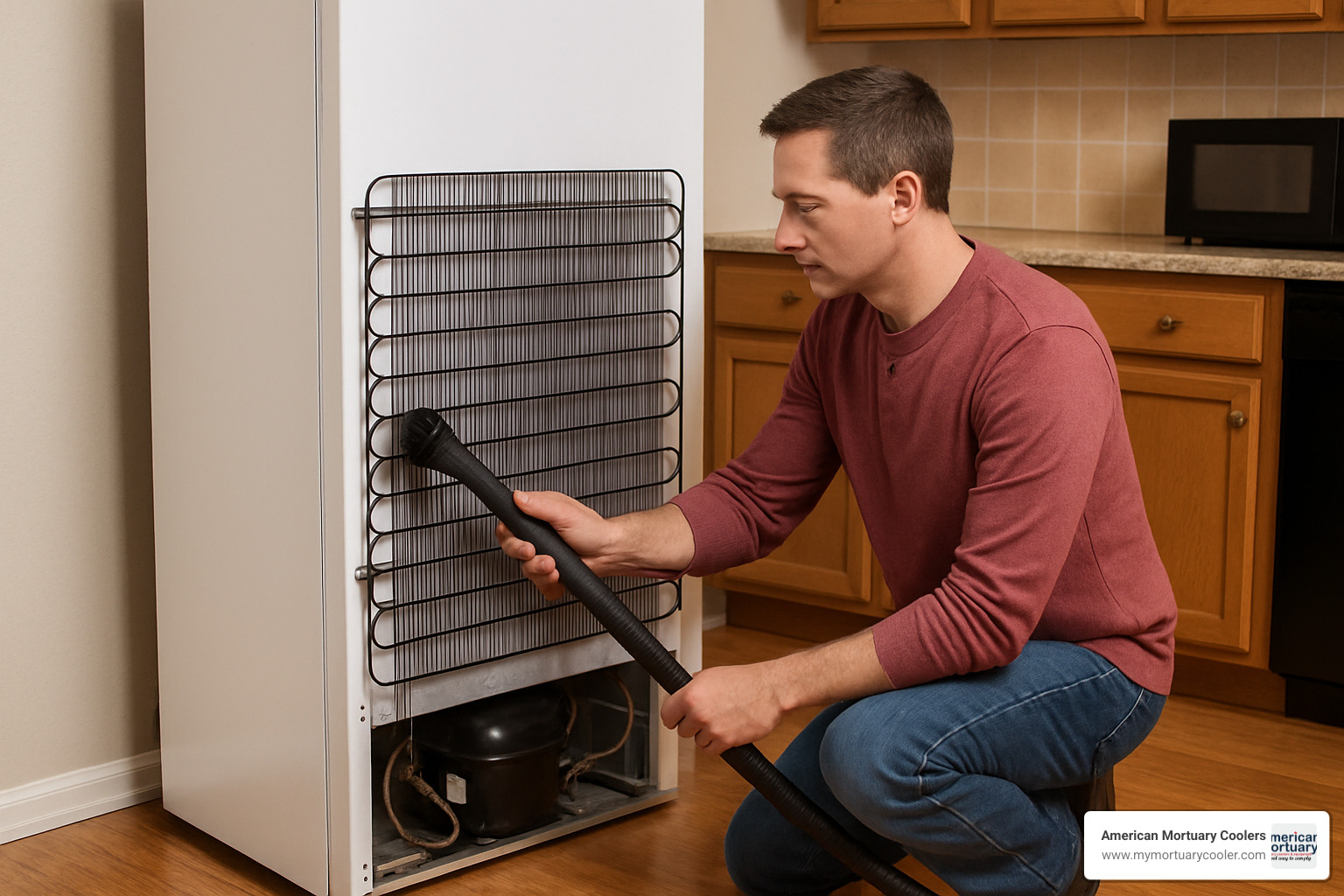
Door Gasket Care
That rubber seal around your refrigerator door might seem insignificant, but it's actually crucial for efficiency. A damaged gasket is like leaving your front door slightly ajar all day – it lets the cold air escape and forces your fridge to work overtime.
Give your gaskets a gentle cleaning with mild soap and water every three months. While you're at it, check for cracks or tears. Here's a quick test: close the door on a dollar bill and try to pull it out. If it slides out easily, your seal isn't as tight as it should be, and it might be time for a replacement.
Water Filter Replacement
If your refrigerator has a water dispenser or ice maker, replacing that filter regularly isn't just about taste – it's about health. Most manufacturers recommend swapping it out every six months. Mark your calendar or set a phone reminder so you don't forget. Your morning glass of water will thank you!
Troubleshooting the Anatomy of Refrigerator: Quick Checks
When your fridge starts acting up, knowing what to check can save you both time and a costly service call.
Refrigerator Not Cooling Properly
Before panicking about all that food going bad, check these common culprits:
First, verify your temperature settings haven't been accidentally changed (it happens more than you'd think!). Then, make sure the interior vents aren't blocked by that giant casserole dish. Listen for the hum of the fan – it should be running regularly. Check that door seal we talked about earlier, and finally, take a peek at those condenser coils to see if they're due for cleaning.
If refrigerant is leaking (signs include reduced cooling and a hissing sound), it's time to call a pro. This isn't a DIY job as refrigerant handling requires proper certification.
Unusual Noises
Your refrigerator should hum quietly, not provide a soundtrack. Different noises can point to specific issues:
A gentle buzzing or humming is normal – that's just your compressor doing its job. Clicking sounds, especially when the compressor tries to start, could indicate relay problems. Rattling might be as simple as something loose on top of your fridge (or as complex as an internal component coming loose). And those gurgling sounds? That's usually just refrigerant flowing through the system – perfectly normal.
Frost Buildup or Ice Formation
Finding a winter wonderland inside your freezer isn't normal. Excessive frost typically points to issues with the defrost system, a compromised door gasket letting in humid air, or a faulty defrost timer or heater. Modern frost-free refrigerators should handle this automatically, so visible frost buildup is a red flag that something needs attention.
Water Leaks
Finding puddles around your refrigerator is never fun. Check for a clogged defrost drain (the most common culprit), leaking water supply lines if you have an ice maker, or condensation issues from a failing door gasket. Sometimes the drip pan simply overflows and needs emptying.
Testing Components with a Multimeter
For the more technically inclined, a multimeter can be your best friend when diagnosing refrigerator problems. You can test thermistors (temperature sensors), check defrost heaters for continuity, verify proper voltage to fans, and confirm if the start relay and overload protector are functioning correctly.
The DIY approach can save you serious money – approximately 70% of refrigerator repair costs go toward labor. That said, if you're not comfortable working with electrical components, there's no shame in calling a professional.
Where to Buy & Replace Key Components
When parts need replacing, you have options:
Manufacturer-specific parts are the gold standard – they'll fit perfectly and won't void any remaining warranty. The downside? They're usually the most expensive option. Find them through the manufacturer's website or authorized dealers.
Third-party replacement parts can save you money, but quality varies widely. Always verify compatibility with your exact model and check reviews before purchasing.
For complex repairs involving the sealed system (compressor, evaporator, condenser), refrigerant handling, or electronic control boards, professional service is usually worth the investment. Some problems are simply beyond the average DIYer's skillset.
At American Mortuary Coolers, we understand the importance of reliable cooling better than most. While our specialty is crafting custom mortuary refrigeration solutions, the principles of refrigeration maintenance apply whether you're preserving food or providing dignified care for the deceased. Just as funeral homes depend on our precision-engineered cooling systems, your family relies on your refrigerator's consistent performance every day.
The science behind refrigerator heat transfer might seem complex, but the maintenance is straightforward. With regular attention to these key areas, your refrigerator will serve you well for many years to come.
Frequently Asked Questions about Anatomy of Refrigerator
Why is the bottom shelf colder than the top?
Ever wondered why ice cream melts faster on the top shelf? It's not your imagination! The bottom of your refrigerator naturally stays colder than the top, and this temperature difference is actually by design.
The anatomy of refrigerator cooling follows basic physics—cold air is heavier than warm air, causing it to sink downward. Manufacturers design refrigerators with this principle in mind. Cold air flows from the evaporator (typically located in the freezer section) and gradually descends through your fridge.
This natural air movement creates distinct temperature zones that are perfect for different types of food. Raw meats and seafood are best stored on those colder bottom shelves where temperatures hover around 32-34°F. Meanwhile, dairy products do well in the middle, and condiments can safely live in those slightly warmer door shelves.
If you've noticed your lettuce freezing on lower shelves, that's why! Delicate produce belongs in those special crisper drawers where both temperature and humidity are regulated to keep your fruits and vegetables fresh without freezing them.
Some premium refrigerator models now include multiple fans and advanced air circulation systems to create more consistent temperatures throughout, but even in these models, physics still wins—the bottom generally remains a few degrees cooler than the top.
How often should I clean condenser coils?
Those hidden condenser coils might be out of sight, but they shouldn't be out of mind! Regular cleaning of these vital components can dramatically improve your refrigerator's efficiency and lifespan.
For most households, cleaning your refrigerator's condenser coils every 6 months is sufficient. However, if you have pets (especially those fluffy ones that shed), you'll want to bump that up to every 2-3 months. Those pet hairs and dander are like kryptonite to your condenser coils! Similarly, if you live in a particularly dusty environment, aim for cleaning every 3-4 months.
Here's why this matters: even a thin 1/4-inch layer of dust on your coils can reduce your refrigerator's efficiency by a whopping 40%. This forces your compressor to work overtime, driving up your electric bill and potentially shortening your appliance's life.
At American Mortuary Coolers, we've seen how critical clean coils are for temperature precision in our specialized units. The same principle applies to your kitchen refrigerator—clean coils mean consistent temperatures, lower energy bills, and fewer repairs.
Can I replace a compressor myself?
While YouTube might make compressor replacement look straightforward, this is one DIY project that's best left to the professionals—and I say this as someone who loves a good DIY challenge!
Replacing a refrigerator compressor involves working with refrigerant—a regulated substance that requires EPA certification to handle legally. There's a good reason for this: improper handling can be hazardous to both you and the environment.
Beyond the regulatory concerns, compressor replacement involves some seriously technical work: brazing copper connections (which requires specialized torches), precise electrical connections, and system evacuation using a vacuum pump. The specialized tools alone would cost more than hiring a professional for most homeowners.
There's also the warranty factor to consider. DIY compressor replacement almost always voids any remaining warranty coverage, leaving you without protection if something else goes wrong.
In our experience at American Mortuary Coolers, where we build cooling systems that must maintain precise temperatures 24/7, proper compressor installation is crucial. Even minor errors in installation can lead to inefficiency, refrigerant leaks, or complete system failure.
If your refrigerator's compressor has failed and your unit is more than 7-10 years old, the most cost-effective solution is usually replacing the entire refrigerator. Today's models are significantly more energy-efficient and come with new warranties and updated features that make replacement the smarter long-term investment.
Conclusion
Understanding the anatomy of refrigerator systems isn't just about satisfying curiosity—it's about empowering yourself to care for an appliance that silently works around the clock to keep your food fresh and family healthy. From the humble compressor pumping away to the carefully designed temperature zones, your refrigerator represents decades of engineering refinement.
The knowledge you've gained about coil cleaning, door gasket maintenance, and troubleshooting common issues will help extend your refrigerator's lifespan and keep it running efficiently. After all, a well-maintained refrigerator uses significantly less energy—good for both your utility bills and the environment.
Here at American Mortuary Coolers, we apply these same fundamental refrigeration principles to our specialized cooling systems, just with improved precision and reliability. Based in Tennessee, we've built our reputation on crafting custom mortuary refrigeration solutions that meet the unique needs of funeral professionals nationwide.
While your home refrigerator keeps food fresh for days, our mortuary systems maintain precise temperatures for much more sensitive purposes—but the science behind both remains remarkably similar. The same vapor-compression cycle powers both, and the same maintenance principles apply.
Our commitment to quality extends beyond just building reliable equipment. We deliver our custom cooling solutions directly to funeral homes across the contiguous 48 states, ensuring that professionals from Seattle to Miami receive the exact specialized refrigeration they need.
For funeral professionals reading this who might be considering upgrading their facilities, we invite you to explore how American Mortuary Coolers can provide custom solutions that address your specific requirements. Our team serves facilities nationwide from our locations in Johnson City TN, Atlanta GA, Chicago IL, Columbia SC, Dallas TX, Los Angeles, New York NY, and Pittsburgh PA.
Whether you're maintaining your kitchen refrigerator or operating specialized cooling equipment, understanding how these systems work empowers you to get the best performance and longevity from them. The principles we've explored apply equally to the refrigerator keeping tonight's dinner fresh and to the specialized systems serving professional needs.
By respecting the neat simplicity of refrigeration technology and providing proper care, you'll enjoy better performance, improved efficiency, and a longer lifespan from these essential cooling systems that quietly make modern life possible.


















